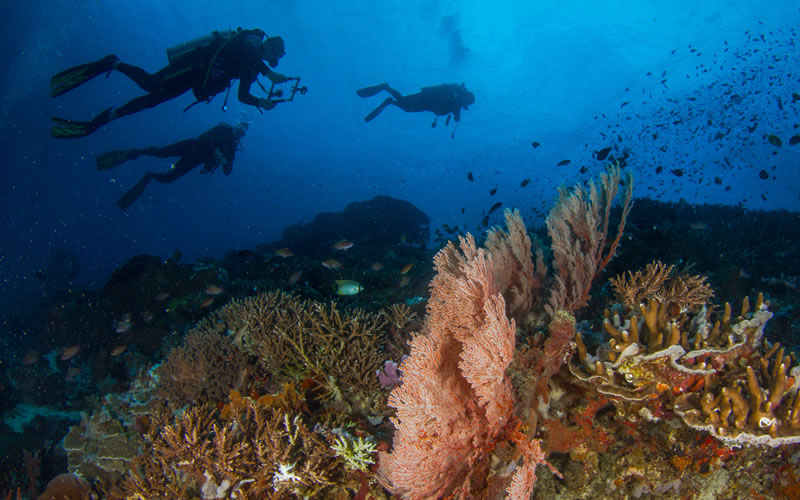How Does Tourism Affect Coral Reefs?

We are drawn to coral reefs. They are colorful, beautiful, and filled with vast amounts of biodiversity that we love to watch and observe. Coral reefs exist in warm tropical regions around the equator that we love to visit when we travel [1]. Unfortunately, our love affair with coral reefs is causing them to be “loved to death”.
While ecotourism has the potential to be a sustainable way to support coastal communities and economies in reef regions without negatively impacting natural resources, in many cases, tourism has caused a great deal of damage to coral reef habitats.
Today, it is estimated that 25% of the world’s coral reefs are damaged beyond repair, with another two-thirds being seriously threatened [2].
Tourist activities that negatively impact coral reefs
Scuba diving and snorkeling
While most diving and snorkeling activities have little physical impact on coral reefs, physical damages to corals can and do occur when people stand on, walk on, kick, touch, trample, and when their equipment contacts corals.
Coral colonies can be broken and coral tissues can be damaged when such activities occur. Divers and snorkelers can also kick up sediment that is damaging to coral reefs.
Boating and anchors
Boats grounding in coral reef habitat can damage corals, as can anchors. Anchors can cause a great deal of coral breakage and fragmentation, particularly from large boats like freighters and cruise ships. Heavy chains from large ships can break or dislodge corals. These damages to corals can last for many years.
Anchoring can also damage the habitats near reefs such as seagrasses that serve as nurseries and habitats for the juveniles of different coral reef organisms.
Marinas may inappropriately dispose of oils and paint residues, polluting local waters, and additional pollution may occur during fueling [3].
Fishing and seafood consumption
An abundance of tourist fishing and consumption of local fish stocks may lead to overexploitation and competition with local fishers.
Inappropriate fishing techniques such as bottom trawling can cause physical damage to reefs.
Cruises and tour boats
These vessels can cause physical damage to reefs through anchoring and grounding, as well as through the release of grey water and human waste into coral reef habitat.
Chemicals added to paint used on boats and fishnets that are intended to discourage the growth of marine organisms can also cause pollution in coral reef waters.
Coastal development
Coastline development and artificial beach creation can result in runoff and sedimentation that washes into ocean waters. This sediment load increases the turbidity in coral reef waters, decreasing the amount of sunlight that can penetrate through the water to reach the corals.
This in turn causes the corals to become stressed, and can eventually lead to bleaching, suffocation, and even coral death. Heavy sedimentation can also lead to decreased coral growth rates, decreased productivity and decreased recruitment.
Demand for souvenirs from the sea
Direct harvesting of coral and other products from the sea by tourists is not very common, but there can be local shops that sell such products in tourist areas. The harvesting of such products can lead to the exploitation of vulnerable marine species.
Pollution from sewage, waste, and chemicals
Sewage or other wastes may be released into the local waters surrounding coral reefs from boats, hotels, or resorts.
Such sewage pollution leads to nutrient enrichment in ocean water, which favors algal growth at the expense of coral organisms.
Inappropriate solid waste disposal can lead to the leaching of toxic chemicals into local waters, and litter (including plastic litter) and debris can blow and wash into coral reef waters [3].
Human encounters with marine life
Fish feeding and encounters with charismatic or rare species can alter the natural behavior of coral reef species, such as foraging behavior, changes in home range size, population density, migration patterns, and reproductive activities.
Changes in the distribution of species may occur, as the more aggressive species will tend to dominate in areas where fish feeding is common. Decreases in overall species abundance have also been observed in some high-use areas.
Invasive species
Invasive marine species can be transported and released into new marine habitats through ballast water and through the washing of ship decks, motors and equipment, water lines, and fishing gear.
How can we reduce negative impacts of tourism on coral reef habitats?
Human behavior change is critical to reduce the negative impacts of tourism on coral reefs.
Tourists must be educated about the negative impacts of destructive activities, the ecological importance of coral reef ecosystems and organisms, and how they can help to preserve coral resources when they travel to these regions.
The level of activity at sites should be reduced through restricted access, and effective and practical regulations that prohibit detrimental actions must also be put in place and properly enforced to prevent pollution and conserve the natural resources of these regions.
Ecotourism activities in these regions should be emphasized and promoted by local communities and the tourism industry as a fun and environmentally-friendly way to vacation in these regions and support the preservation of coral reef ecosystems.
References
[1] http://www.coral-reef-info.com/where-are-coral-reefs-located.html
[2] http://goo.gl/sv0rD6
[3] http://goo.gl/Cf5R52

